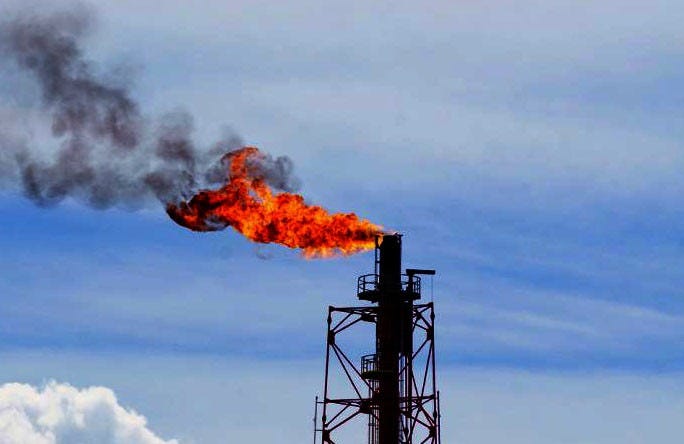Turkmenistan: President flaunts green credentials after methane cut
Turkmenistan made impressive strides in slashing its methane emissions in 2023, achieving a 10 percent reduction on the volume of emissions seen in 2020.
For the leader of one of the world’s most delinquent polluters, gas-rich Turkmenistan’s president waxes very green these days.
In a speech delivered at the BRICS outreach meeting in Kazan last week, Serdar Berdymukhamedov talked of how the climate is central to global security and prosperity.
And to his credit, Berdymukhamedov has earned eco-bragging rights – up to a point.
As Antoine Halff, a co-founder of Kayrros, an environmental monitoring firm, told an energy industry conference in Ashgabat last week, Turkmenistan made impressive strides in slashing its harmful methane emissions in 2023, achieving a 10 percent reduction on the volume of emissions seen in 2020.
That puts Turkmenistan well on target to meet its commitments to the Global Methane Pledge, a voluntary commitment launched at the COP-26 climate summit in Glasgow in 2021. That pledge aims to reduce global methane emissions by at least 30 percent by 2030 relative to 2020 levels.
In a report published last month, Kayrros noted that Turkmenistan is ahead of schedule.
What Turkmenistan achieved in 2023 is “a slightly steeper reduction than the 9 percent notional cut required in a linear progression towards 2030 targets,” the company said.
“Until now, most of the decline in emissions has come from the eastern part of the country, where the bulk of gas production is located. The Western part is mostly producing oil,” the author of the Kayrros report wrote. “Emissions from both producing regions look set to now fall steeply in the wake of new commitments and policy measures announced by Ashgabat over the last year.”
This is high praise indeed from the same company that sounded the alarm over Turkmenistan in the first place. As the Guardian reported last year, data produced by Kayrros showed that emissions from two fields in Turkmenistan were chugging out amounts of CO2-equivalent emissions in 2022 comparable to the annual emissions of the United Kingdom.
Berdymukhamedov may now wish to claim all the credit for this breakthrough, although plaudits should just as equally be reserved for the gentle but insistent diplomacy of figures like John Kerry, the U.S. special envoy on the climate.
On the eve of the COP-28 climate summit in Dubai in December, when Turkmenistan formally declared its commitment to the Global Methane Pledge, Kerry reached out to Berdymukhamedov by phone to do some more last-minute persuading.
The United Nations is eager to keep this momentum going. Earlier this month, Dario Liguti, head of the sustainable energy division at the United Nations Economic Commission for Europe (UNECE), held talks with the Turkmen Foreign Ministry that touched in part on the importance of methane management in the country’s oil and gas operations. The UNECE said it wants to support Turkmenistan in building “effective” monitoring, reporting, and verification systems for methane reduction.
For effective, read credible.
As Turkmenistan’s National Strategy on Climate Change explains, it falls to the State Statistics Committee to compile data on emissions on the basis of information submitted by domestic monitoring bodies and government ministries. But the reality is that the State Statistics Committee and much of the figures it produces are largely a sham.
Partners like the World Bank and the International Monetary Fund have nevertheless historically reproduced State Statistics Committee data without fuss. This is changing, though. And it is one thing to embellish GDP growth figures – but when it comes to the country’s possible impact on the global climate, accuracy is far more important.
All this makes it significant that the Oil and Gas of Turkmenistan Conference held in Ashgabat last week should have involved so many notable figures in the global methane emissions reduction community. Speakers included Manfredi Caltagirone, head of the International Methane Emissions Observatory (IMEO), a body that operates under the auspices of the United Nations Environment Program (UNEP), Mark Davis, chief executive of real-time gas flaring detection company Capterio, and James Turitto, director of global campaigns at the Clean Air Task Force, a nongovernmental group that advocates for reducing harmful emissions. Halff from Kayrros and Liguti of the UNECE were also involved.
This will be heartening to champions of the methane emissions cutting-agenda. There is, however, lack of clarity about the specific steps that will follow. Or whether the progress that has been attained so far is going to endure.
A recent comparative study of methane reduction policies implemented by 15 key emitting nations notes that Turkmenistan is faring poorly.
“Turkmenistan’s approach is limited to general climate change policies … but lacks specific sectoral strategies,” concluded the report, which was jointly conducted by the University of Maryland’s Centre for Global Sustainability and Energy Foundation China.
This is not surprising since Turkmenistan’s policymaking mechanisms, such as they are, depend entirely on the whims of the president, and his father and de facto co-leader, Gurbanguly Berdymukhamedov.
Green issues are in favour at the presidential palace in Ashgabat right now. If they fall out of fashion, that will spell trouble for the emissions-cutting agenda.




